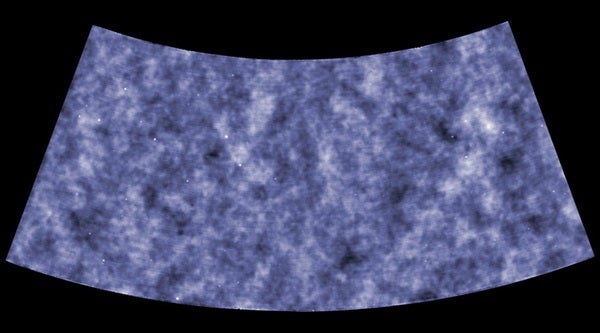Analysis of data from the 10-meter South Pole Telescope (SPT) is providing new support for the most widely accepted explanation of dark energy — the mysterious force that is responsible for the accelerating expansion of the universe. The data strongly support Einstein’s cosmological constant, even though the analysis was based on only a fraction of the SPT data collected and only 100 of the over 500 galaxy clusters detected so far.
The results also are beginning to home in on the masses of neutrinos, the most abundant particles in the universe.
“With the full SPT dataset, we will be able to place extremely tight constraints on dark energy and possibly determine the mass of the neutrinos,” said Bradford Benson from the University of Chicago’s Kavli Institute for Cosmological Physics in Illinois.
“Right now, the forefront of physics is observational cosmology,” said Antony Stark from the Harvard-Smithsonian Center for Astrophysics in Cambridge, Massachusetts. “We observe signs of dark energy, dark matter, and early inflation, but we don’t understand any of them. The South Pole Telescope’s mission is to provide some answers.”
The latest results are based on a new method that combines measurements taken by the SPT with those from orbiting X-ray satellites, and extends these measurements to larger distances than previously achieved using galaxy clusters.
The most widely accepted property of dark energy is that it leads to a pervasive force acting everywhere and at all times in the universe. This force could be the manifestation of Einstein’s cosmological constant, which he considered to be one of his greatest blunders after learning that the universe is expanding.
Einstein introduced the factor into his general theory of relativity to accommodate a stationary universe, the dominant idea of his day. But his constant fits nicely into the context of an accelerating universe, now supported by countless astronomical observations. Others hypothesize that gravity could operate differently on the largest scales of the universe. In either case, the astronomical measurements are pointing to new physics that has yet to be understood.
The SPT was specifically designed to tackle the dark energy mystery. The 10-meter telescope operates at millimeter wavelengths to make high-resolution images of the cosmic microwave background (CMB) — the light left over from the Big Bang. Scientists use the CMB in their search for distant, massive galaxy clusters that can be used to pinpoint the properties of dark energy and the mass of the neutrino.
“The CMB is literally an image of the universe when it was only 400,000 years old, from a time before the first planets, stars, and galaxies formed in the universe,” Benson said. “The CMB has traveled across the entire observable universe for almost 14 billion years and during its journey is imprinted with information regarding both the content and evolution of the universe.”
As the CMB passes through galaxy clusters, the clusters effectively leave “shadows” that allow astronomers to identify the most massive clusters in the universe, nearly independent of their distance.
“Clusters of galaxies are the most massive, rare objects in the universe, and, therefore, they can be effective probes to study physics on the largest scales of the universe,” said John Carlstrom from the University of Chicago.
The number of clusters that formed over the history of the universe is sensitive to the influence of dark energy on the growth of cosmic structures, as well as the mass of neutrinos. If they are too massive, they would significantly affect the formation of galaxies and galaxy clusters.
The SPT team has now placed tight limits on neutrino masses, yielding a value that approaches predictions stemming from particle physics measurements.










